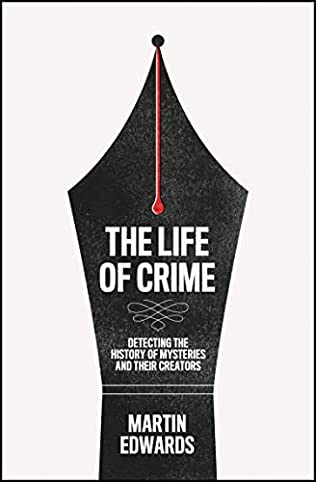The Life of Crime: Detecting the History of Mysteries and Their Creators
- By Martin Edwards
- Collins Crime Club
- 736 pp.
- Reviewed by Bob Duffy
- August 19, 2022
Whodunit fans should dive into this broad, if not deep, informative pool.

This massive chronicle of crime fiction comes as close to being exhaustive as author Martin Edwards’ near-manic expertise and reading experience allow. In it, he covers hundreds of writers in 55 chapters organized topically (e.g., “The Mistress of Deception: Agatha Christie”; “Waking Nightmares: Noir Fiction”; and “In Lonely Rooms: Raymond Chandler”). Each concludes with a hefty block of fine-print notes that sweep up loose ends. And the whole package is capped with three indices (title, name, and subject) and 20 pages of “select” bibliography perfect for selective dipping and further reading.
Could the devout mystery fan wish for anything more? Well, perhaps…especially if she or he is seeking critical depth or insight into stylistic crosscurrents. The Life of Crime, which — face it — is essentially a biographical survey, has singular virtues and pesky drawbacks alike; ironically, they often coincide. The book powers forward like a human-wave assault, covering all the big names, but then draws the reader into a swarm of lesser lights, including the vaguely familiar and the near obscure.
No blame from this quarter, as that’s what Edwards clearly intended. But remember: You won’t find much substantive detail here, even among the biggies. If you want to dig deeper, you’ll have to follow the clues in Edwards’ excellent chapter endnotes and bibliography.
That said, The Life of Crime offers many compensating delights, and it amply satisfies the modern appetite for chatty anecdote and casual factoid. Each chapter kicks off with a compelling vignette or two, for instance:
- In the real world, the vaunted “Ellery Queen” was a pair of collaborating cousins, one supplying the plot, the other shouldering the writing. But like a literary Martin and Lewis, the two couldn’t manage to get along, even amid the cascade of big bucks their teamwork produced.
- In counterpoint to the above, contemporary American author Charles Todd happily teams with his uncredited mom on their Britain-set procedurals. And then there’s racetrack sleuth-smith Dick Francis, who gallantly deferred most of the actual writing to his wife, Mary. Until her death in 2000, that is, when — after a few years of respectful hesitation — their son Felix stepped into the breach. The winning streak continues, even after Francis père’s recent death.
- In a bout of pillow talk with his lover, the playwright Lillian Hellman, Dashiell Hammett reputedly copped to a youthful murder he carried out while serving as a Pinkerton heavy on strike-breaker assignment. (Edwards calls B.S. on this vainglorious unburdening, or at least the killing part.)
- Vera Caspary (who?), during a sweltering spell, took to writing naked at an open window in her city home. And, oh yes, she was also a communist. Figures.
- You might contrast birthday-suit-Vera with Mary Katherine Green, dubbed by somebody or other “the mother of detective fiction.” In Edwards’ wondrously evocative phrasing, her early-20th-century storytelling was “as decorously Victorian as covered piano legs.”
- Eleanor Roosevelt borrowed Miss Marple’s gumshoe cred in several whodunits penned by her son Elliott. And in a more prominent case of cashing in on a presidential name, Margaret Truman, Harry’s daughter, produced a raft of Washington-themed mysteries, some of which are still in print. But both Elliott and Margaret reputedly employed ghostwriters, snipes Edwards.
- Alfred Hitchcock, no mystery writer himself but instantly alert to the adaptive potential of the genre, directed a brace of suspense classics based on novelistic thrillers, including “The Lady Vanishes,” “Strangers on a Train,” “Rear Window,” “Vertigo,” and “The Birds.”
Another instructive take-away from the book: The larger share of the creation, promotion, and audience appeal of suspense writing belongs to women authors. “Men dominated British crime fiction for the first three decades of the twentieth century,” writes Edwards. “From then on Christie, [Dorothy L.] Sayers, [Margery] Allingham and [Ngaio] Marsh took center stage. Even the most gifted male contemporaries…never quite matched their sales and reputations.”
Edwards is also appreciative of more recent women writers. Patricia Highsmith, E.P. James, and Ruth Rendell, among others, receive full-chapter treatment.
Yet there are blind spots, too, despite the broad scope of Edwards’ historical rundown. One particularly glaring lapse: There’s not a single word about Elmore Leonard! And James Lee Burke receives only passing mention. Irish writers notably fail to make much of an impression on our British host, either. Tana French, Benjamin Black (John Banville), and the emerging crop of Ulster crime writers garner scant, if any, coverage.
This latter lapse is regrettable and perhaps a little annoying, but it’s not a thrill-killer. Yes, we all have our favorites, and their omission from Edwards’ roll call rankles a bit. Even so, The Life of Crime — whether you read it through or shelve it for moments of curious interest — is worth investigating if you love crime fiction.
Bob Duffy is a Maryland author and retired advertising executive.

